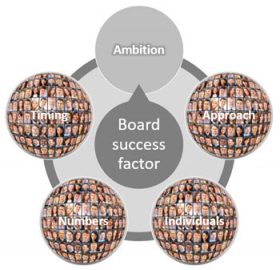How can we catch the attention of board members?
Why is it so tough to sell intercultural training to Japanese boards?
In Japan, the unspoken reality is that everyone expects foreigners to adapt to Japanese culture, with little adjustment by the Japanese.
Diversity here is generally interpreted to mean bringing women into the workplace. This is a good start, but they are a long way from including cultural diversity.
The Japanese have a closed, insider’s view of themselves as a people who understand each other deeply. They have created barriers towards outsiders and find it difficult to imagine constructive roles for non-Japanese in organizational structures that previously existed in a purely Japanese context. More on Japanese boards…
Senior execs are sometimes the hardest people to convince of the benefits of intercultural training. But following these steps can help you win support for your intercultural training proposal.
Use the template presentation as your starting point to build a board-friendly case for intercultural competence development.
The approach is employed by diversity and inclusion consultant Elizabeth Masamune in the world’s toughest market for intercultural training: Japanese corporations in Japan
Meet them where they are

Let’s be realistic, your intercultural training proposal is not going to cause the Board to take a sudden left-turn on strategy, nor replace their current priorities. You need to walk alongside them at a similar pace, as they lead the organisation in their chosen strategic direction.
Introduce the topic in way that is directly relevant to their immediate interests, as if your solution is created uniquely for this organisation and this executive team in this financial year.
At this stage, it’s unlikely that they need you to challenge their assumptions or to create an alternative vision. Come with the spirit of an insider, with solutions appropriate to where the organisation is now, and pulling in the direction the Board is already driving towards.
If that means acting as interpreter, coach, mediator or communicator, make sure your role is in tune with the ambitions and preferences of the Board.
Use the right language

Increasingly board members are able to talk the talk on diversity. Very often, implementation is lacking because real concrete steps to build intercultural competence still seem alien, strange and outside the normal business dialogue.
Make your proposal digestible:
- the language you choose
- how you frame the business problem
If there are buzzwords and current hot topics your board is dealing with for their core strategic, financial, branding or customer-facing discussions, adopt the same buzzwords and hot topics for your presentation of the case for intercultural training, dropping the normal cross-cultural jargon which can alienate people outside this specialist field.
Go forward step-by-step. Don’t immediately reach for the latest and greatest solutions happening anywhere in the world. Appreciate the possibility that board members are like most humans: they prefer to be among people who think and talk like them. They may naturally reject diversity, preferring team and institutional unity and the comfort of group-think.
board members are like most humans: they prefer to be among people who think and talk like them
Many leaders do not get to inclusion in one step. First, you may need to establish the principle of accepting diversity. Moving forward to policies for inclusion may still be a few steps ahead.
This is where the training comes in. Boards need to accept diversity in principle first. Many top execs know they should have people of diverse backgrounds joining the board, but at the same time they don’t want that. Use intercultural training for the board themselves as way to introduce business opportunities, not as a correction to wrong behaviour.
Find the decision-makers and thought leaders

A board meeting may not be the best moment to first introduce your proposal. You probably cannot do this in a group situation. You’ll just get a general nodding of heads. Long before any presentation at a Board meeting, you need to corner the decision-maker and get him/her on your side.
Find the thought-leaders. There is usually at least one in every industry, even in the most conservative sector. By the time you get to the board meeting, you need to have already won over some advocates and allies on the board. Make this their presentation and their success, not yours.
Show the numbers

Link intercultural competence to business results. If you’ve got the numbers, use them. If you think that culture is a soft skill, think again. Consider the way the board will be familiar with even softer concepts of brand or customer satisfaction, where they expect – and get – hard numbers.
Many approaches to measurement are available. You may present a financial project of added value, a cost-reduction formula based on avoided mistakes, a case from the business or industry with a solid numerical analysis. Back it up with research from outside the business, if necessary.
Get the timing right

Board members are exceptionally busy and everyone wants a slice of their time. It is a rare Board executive who will predict and prepare for future intercultural competence requirements. But they will listen when culture has started to bite, especially bite into profits.
There are certain moments in an organisation’s story when culture really matters. It may be a merger or acquisition, a scandal or crisis, a new CEO, a regulatory change, a strategic review or some other disturbance – positive or negative – to normal operation.
Be ready to help the organisation through this key moment. When you have the right solution at a time when the business challenge which your solution addresses is near the top of the board’s agenda, and you’re using familiar language including numbers, setting a realistic ambition level and working with supportive individual members, you’ll get the full attention of the board.
This is your moment to make culture a true business priority.
Downloadable template: proposal to the board – intercultural training
Get this example of a proposal targeted at Board-level executives in PPTX format

